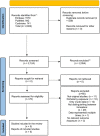Maternal alcohol consumption and the risk of miscarriage in the first and second trimesters: A systematic review and dose-response meta-analysis
- PMID: 37221907
- PMCID: PMC10333669
- DOI: 10.1111/aogs.14566
Maternal alcohol consumption and the risk of miscarriage in the first and second trimesters: A systematic review and dose-response meta-analysis
Abstract
Introduction: According to a precautionary principle, it is recommended that pregnant women and women trying to conceive abstain from alcohol consumption. In this dose-response meta-analysis, we aimed to examine the association between alcohol consumption and binge drinking and the risk of miscarriage in the first and second trimesters.
Material and methods: The literature search was conducted in MEDLINE, Embase and the Cochrane Library in May 2022, without any language, geographic or time limitations. Cohort or case-control studies reporting dose-specific effects adjusting for maternal age and using separate risk assessments for first- and second-trimester miscarriages were included. Study quality was assessed using the Newcastle-Ottawa Scale. This study is registered with PROSPERO, registration number CRD42020221070.
Results: A total of 2124 articles were identified. Five articles met the inclusion criteria. Adjusted data from 153 619 women were included in the first-trimester analysis and data from 458 154 women in the second-trimester analysis. In the first and second trimesters, the risk of miscarriage increased by 7% (odds ratio [OR] 1.07, 95% confidence interval [CI] 0.96-1.20) and 3% (OR 1.03, 95% CI 0.99-1.08) for each additional drink per week, respectively, but not to a statistically significant degree. One article regarding binge drinking and the risk of miscarriage was found, which revealed no association between the variables in either the first or second trimester (OR 0.84 [95% CI 0.62-1.14] and OR 1.04 [95% CI 0.78-1.38]).
Conclusions: This meta-analysis revealed no dose-dependent association between miscarriage risk and alcohol consumption, but further focused research is recommended. The research gap regarding miscarriage and binge drinking needs further investigation.
Keywords: alcohol consumption; binge drinking; miscarriage; pregnancy; spontaneous abortion.
© 2023 The Authors. Acta Obstetricia et Gynecologica Scandinavica published by John Wiley & Sons Ltd on behalf of Nordic Federation of Societies of Obstetrics and Gynecology (NFOG).
Conflict of interest statement
The authors have stated explicitly that there are no conflicts of interest in connection with this article.
Figures



Similar articles
-
Amniocentesis and chorionic villus sampling for prenatal diagnosis.Cochrane Database Syst Rev. 2017 Sep 4;9(9):CD003252. doi: 10.1002/14651858.CD003252.pub2. Cochrane Database Syst Rev. 2017. PMID: 28869276 Free PMC article.
-
Antioxidants for female subfertility.Cochrane Database Syst Rev. 2017 Jul 28;7(7):CD007807. doi: 10.1002/14651858.CD007807.pub3. Cochrane Database Syst Rev. 2017. Update in: Cochrane Database Syst Rev. 2020 Aug 27;8:CD007807. doi: 10.1002/14651858.CD007807.pub4. PMID: 28752910 Free PMC article. Updated.
-
Methods for managing miscarriage: a network meta-analysis.Cochrane Database Syst Rev. 2021 Jun 1;6(6):CD012602. doi: 10.1002/14651858.CD012602.pub2. Cochrane Database Syst Rev. 2021. PMID: 34061352 Free PMC article.
-
Subsequent pregnancy outcomes after second trimester miscarriage or termination for medical/fetal reason: A systematic review and meta-analysis of observational studies.Acta Obstet Gynecol Scand. 2024 Mar;103(3):413-422. doi: 10.1111/aogs.14731. Epub 2023 Nov 30. Acta Obstet Gynecol Scand. 2024. PMID: 38037500 Free PMC article.
-
Application of seminal plasma to female genital tract prior to embryo transfer in assisted reproductive technology cycles (IVF, ICSI and frozen embryo transfer).Cochrane Database Syst Rev. 2018 Feb 28;2(2):CD011809. doi: 10.1002/14651858.CD011809.pub2. Cochrane Database Syst Rev. 2018. PMID: 29489026 Free PMC article.
Cited by
-
Investigation of Uncovering Molecular Mechanisms of Alcohol-Induced Female Infertility-A Rational Approach.Reprod Sci. 2024 Dec;31(12):3660-3672. doi: 10.1007/s43032-024-01692-8. Epub 2024 Nov 1. Reprod Sci. 2024. PMID: 39485609 Free PMC article. Review.
-
A Systematic Review of Mendelian Randomization in Spontaneous Miscarriage.J Multidiscip Healthc. 2025 Apr 21;18:2237-2246. doi: 10.2147/JMDH.S515367. eCollection 2025. J Multidiscip Healthc. 2025. PMID: 40292224 Free PMC article. Review.
-
Maternal alcohol consumption during pregnancy and associated factors among pregnant women in Tanzania: evidence from the 2022 Tanzania Demographic and Health Survey.BMC Pregnancy Childbirth. 2025 Mar 27;25(1):359. doi: 10.1186/s12884-025-07149-3. BMC Pregnancy Childbirth. 2025. PMID: 40148758 Free PMC article.
-
Preconception alcohol consumption in both partners and risk of miscarriage.Reprod Biomed Online. 2025 Aug;51(2):104698. doi: 10.1016/j.rbmo.2024.104698. Epub 2024 Oct 29. Reprod Biomed Online. 2025. PMID: 40335389
References
-
- Kesmodel U. Alkohol og graviditet [alcohol and pregnancy]. Ugeskr Laeger. 1999;161:4989‐4994. - PubMed
-
- Popova S, Lange S, Probst C, Gmel G, Rehm J. Estimation of national, regional, and global prevalence of alcohol use during pregnancy and fetal alcohol syndrome: a systematic review and meta‐analysis. Lancet Glob Health. 2017;5:e290‐e299. - PubMed
-
- Strandberg‐Larsen K, Andersen A‐MN, Kesmodel US. Unreliable estimation of prevalence of fetal alcohol syndrome. Lancet Glob Health. 2017;5(6):e290‐e299. - PubMed
-
- Flak AL, Su S, Bertrand J, Denny CH, Kesmodel US, Cogswell ME. The association of mild, moderate, and binge prenatal alcohol exposure and child neuropsychological outcomes: a meta‐analysis. Alcohol Clin Exp Res. 2014;38:214‐226. - PubMed
Publication types
MeSH terms
LinkOut - more resources
Full Text Sources
Medical
Miscellaneous

